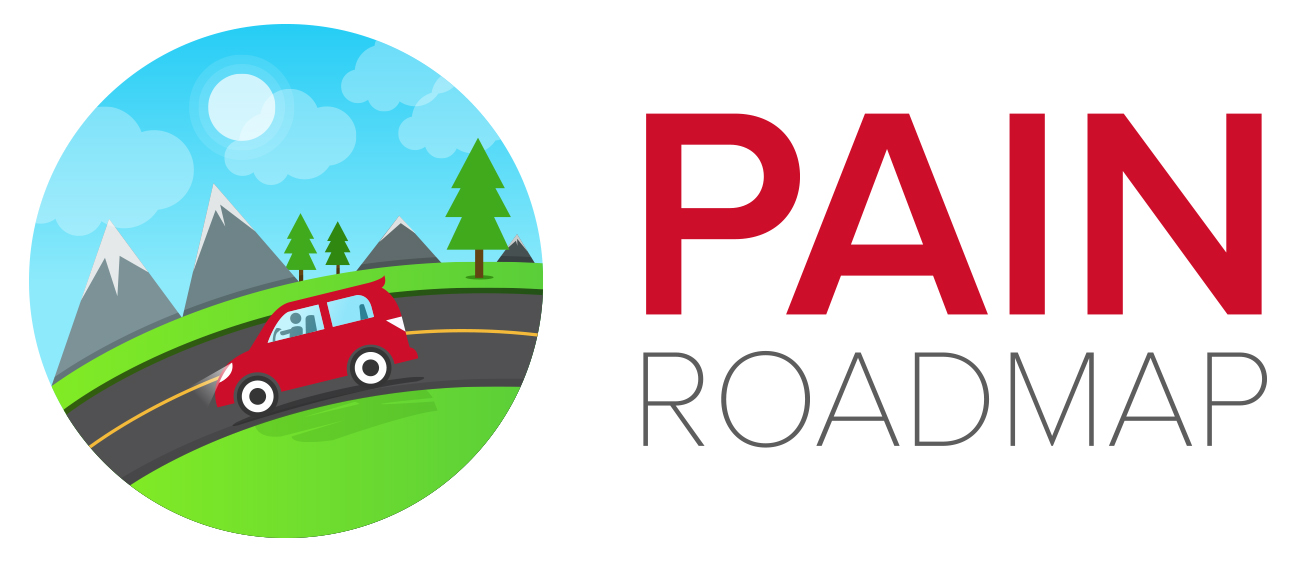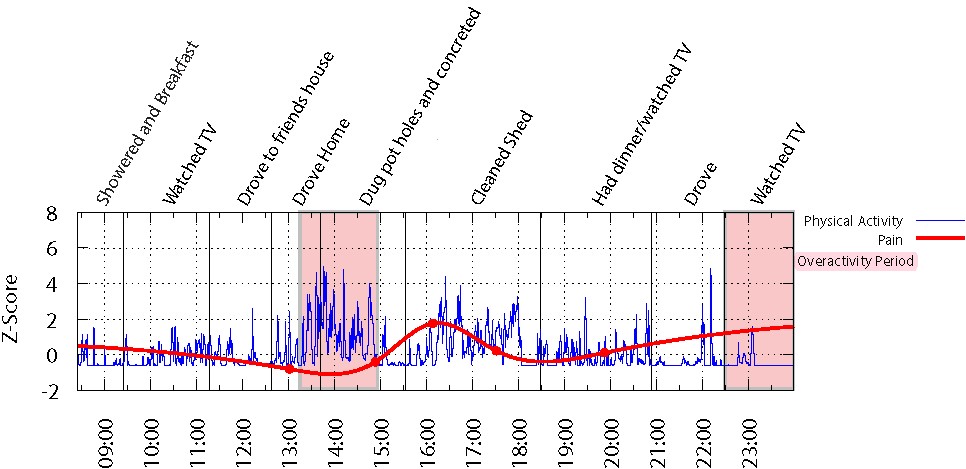A Mobile app to help people with chronic pain
Chronic pain (sometimes referred to as persistent pain) is pain that lasts longer than three months, long beyond the time expected for healing after an injury, surgery or other condition. Chronic pain can be the symptom of another condition (e.g. migraine, arthritis, fibromyalgia and other musculoskeletal conditions) but it can also be a standalone condition. Chronic pain can impact all areas of a person’s social functioning and can also affect their emotional and mental wellbeing.
Managing chronic pain conditions can be difficult as pain is a complex condition and everyone responds differently to it.
Activity pacing
One way that pain can be managed is by a technique called activity pacing. Dr Nicole Andrews explains:
 "For people with chronic pain, physical activity is like a double edge sword. While we encourage people with chronic pain to exercise and be active, doing too much, in one go, can significantly worsen pain levels resulting in pain flare ups that negatively impact one's life. People who experience frequent pain flare ups often describe being unable to work and do the things that are important in life. Many people need to take extra medication to cope with pain flare-ups. Activity pacing involves breaking up and scheduling daily tasks in a way that allows people with pain to be active without aggravating their pain. With activity pacing, tasks that were originally unachievable become manageable and people find that they can achieve more things throughout the day. Activity pacing allows people to engage more with activities that are important to them, such as work or spending quality time with family, without needing to take extra medication."
"For people with chronic pain, physical activity is like a double edge sword. While we encourage people with chronic pain to exercise and be active, doing too much, in one go, can significantly worsen pain levels resulting in pain flare ups that negatively impact one's life. People who experience frequent pain flare ups often describe being unable to work and do the things that are important in life. Many people need to take extra medication to cope with pain flare-ups. Activity pacing involves breaking up and scheduling daily tasks in a way that allows people with pain to be active without aggravating their pain. With activity pacing, tasks that were originally unachievable become manageable and people find that they can achieve more things throughout the day. Activity pacing allows people to engage more with activities that are important to them, such as work or spending quality time with family, without needing to take extra medication."
People with chronic pain can struggle to identify which activities may cause the most problems for them, and so Dr Andrews and colleagues have created a mobile phone platform called Pain ROADMAP. Pain ROADMAP is designed to monitor people with chronic pain and accurately detect the activities that caused pain flare ups. Pain ROADMAP stems from consumer feedback and is based on previous research. Pain RAODMAP was developed through a collaboration between the University of Queensland, CSIRO and the Tess Cramond Pain and Research Centre.
How does Pain ROADMAP work?

Pain ROADMAP monitors activity, symptoms and behaviour over the course of a week. This involves wearing an activity tracker (a FitBit like device) either around the waist or wrist. Pain intensity, opioid medication use and activities undertaken throughout the day are entered into the Pain ROADMAP mobile phone app. Clinicians then upload this information onto an online portal where the data is integrated and analysed. One of the Pain ROADMAP portal's outputs is a visual record linking specific activities with changes in pain. An example of this is shown below in Figure 1.
Figure 1. Example of daily graph generated by the Pain ROADMAP portal

Both too much physical activity and prolonged sedentary postures (e.g. prolonged sitting) can worsen pain and cause pain flare ups. This is demonstrated in the graph above which represents one day of monitoring for a gentleman with generalised musculoskeletal pain (e.g. Low back pain and Osteoarthritis). There are two instances where activity engagement contributed to a pain flare up (activities shaded pink). The first instance of a spike in pain (red line) occurs at 16:00 after a prolonged period of engagement in high levels of physical activity (blue line). The spike in objective activity observed can be linked to the diary activity 'dug pot holes and concreted' and a subsequent increase in significant pain. The second instance relates to a gradual escalation in pain caused by a prolonged period in a static posture (i.e. a seated position) towards the end of day at 23:00 from watching TV directly after an extended period of driving. It is not surprising therefore, that this gentleman had a restless night sleep, called in sick to work and needed to take opioid medication to cope the following day. These outcomes can only be reversed once we can recognise which activities caused the pain flare up and modify these activities.
Clinicians can use data from Pain ROADMAP to provide very specific feedback and advice on how pain provoking activities can be modified and how daily routines can be altered so people are in less pain and can do more of the things that are important to them. The Pain ROADMAP portal also monitors progress overtime such as productivity, physical activity levels, pain levels and opioid use. This feedback is important for determining if treatments are working and motivating people to continue with pain management strategies that are helpful.
Implementing Pain ROADMAP
To evaluate Pain ROADMAP, we conducted a pilot implementation study with 20 adults who had chronic pain. As part of a 15-week treatment protocol, participants received feedback from three dispersed 1-week Pain ROADMAP monitoring periods. Treatment focused on adapting pain-provoking activities, gradually increasing goal-related activity and optimising routine.
The main findings from this pilot implementation were:
- For the most part, participants were able tolerate and adhere to the Pain ROADMAP monitoring procedures.
- All participants who filled in the evaluation questionnaire at the end of the study indicated that Pain ROADMAP feedback was valuable and that it was worth undergoing the monitoring to receive the feedback that was provided by the clinician.
- Participants who completed the 15-week treatment protocol, had a significant reduction in activity related pain flare ups and experienced a stablisation in their pain levels.
- Clinically meaningful decreases in opioid use, depression, activity avoidance and increases in productivity were also observed.
- A few participants commented that the Actigraph activity monitor was bulky and that the ability to wear the monitor on other parts of the body would improve Pain ROADMAP monitoring.
- Participants recommended a number of minor adaptions to the app such as customisable notification tones and the ability to edit data once it has been entered.
- Two participants who were under the age of 25 dropped out of the study early. Hence, strategies may be needed to ensure mHealth assisted treatments are engaging for young people such as the use of gamification to increase motivation.
Adapting Pain ROADMAP for young people with chronic pain
A paediatric Pain ROADMAP working group was formed with expert pain clinicians across Australia to inform the adaption of Pain ROADMAP for young people with chronic pain (i.e. young adults and adolescents). The working group had representation from the following organisations:
- Perth Children's Hospital
- Queensland Children's Hospital
- SKIP (Support Kids in Pain)
- The Royal Children's Hospital Melbourne
- St Vincent's Brisbane
- Tess Cramond Pain and Research Centre
- The Australian e-Health Research Centre, CSIRO
- RECOVER Injury Research Centre, The University of Queensland
The main themes that arose from these working groups were:
- Added option of measuring zones of regulation as opposed to pain
- Optional setting for most app features (e.g. measuring opioid intake)
- Non-immersive gamification of the Pain ROADMAP app
- Gamification elements need to suitable for different ages and gender neutral
- Pain education built into the app
Outcome from consultation
Ideas generated from the paediatric Pain ROADMAP working group informed three research projects:
- Gamification and modification of the Pain ROADMAP app followed by a multisite trial to investigate the effectiveness of the gamification element across different age groups
- Development and pilot testing of a pain history assessment and education chatbot named Dolores. More information about Delores can be viewed here.
- Adaption the Pain ROADMAP treatment protocol to incorporate more targeted opioid tapering support and evaluation this protocol for supporting people with chronic pain who desire to reduce their opioid dose.
Awards
The Pain ROADMAP project has received numerous awards recognising outstanding innovation, digital technology development and research.
Winner – The 2022 University of Queensland Early-Mid Career Researcher Industry Engagement Award.
Merit Award – Research and Development Project of the Year. 2019 National iAwards.
Merit Award - Data Insights Innovation of the Year. 2019 National iAwards.
Winner - Research and Development Project of the Year. 2019 QLD iAwards.
Merit Award - Data Insights Innovation of the Year. 2019 QLD iAwards.
Merit Award - Community Services Category. 2019 QLD iAwards.
Links to Relevant Publications
Andrews, N. E., Ireland, D., Deen, M. and Varnfield, M. (2023).Clinical Utility of a mHealth Assisted Intervention for Activity Modulation in Chronic Pain: The Pilot Implementation of Pain ROADMAP. European Journal of Pain. doi: 10.1002/ejp.2104
Ireland, David and Andrews, Nicole (2019).Pain roadmap: A mobile platform to support activity pacing for chronic pain. 27th Australian National Health Informatics Conference (HIC 2019), Melbourne, Australia, 12 – 14 August, 2019. Amsterdam, Netherlands: IOS Press. doi: 10.3233/SHTI190778
Andrews, Nicole Emma, Strong, Jenny, Meredith, Pamela Joy, Gordon, Kellie and Bagraith, Karl Singh (2015)."It's very hard to change yourself": an exploration of overactivity in people with chronic pain using an interpretative phenomenological analysis. Pain, 156 (7), 1215-1231. doi: 10.1097/j.pain.0000000000000161
Andrews, Nicole Emma, Strong, Jenny and Meredith, Pamela Joy (2015).Overactivity: is it a valid construct?. PAIN, 156 (10), 1991-2000. doi: 10.1097/j.pain.0000000000000259
Andrews, Nicole E., Strong, Jenny, Meredith, Pamela J. and Branjerdporn, Grace S. (2018).Approach to activity engagement and differences in activity participation in chronic pain: a five-day observational study. Australian Occupational Therapy Journal, 65 (6), 575-585. doi: 10.1111/1440-1630.12516
Join our Pain ROADMAP Mailing List
Join our Pain ROADMAP mailing list to keep up to date on the latest updates, research findings, and opportunities to get involved.
